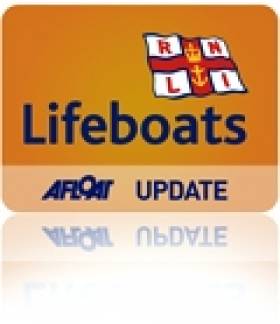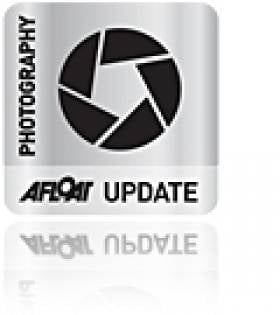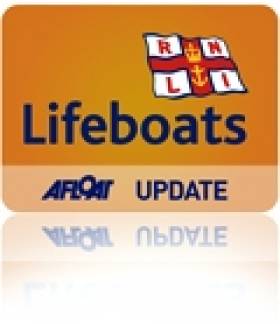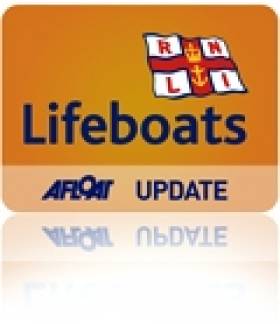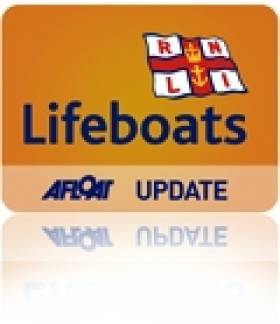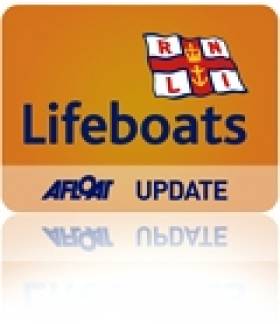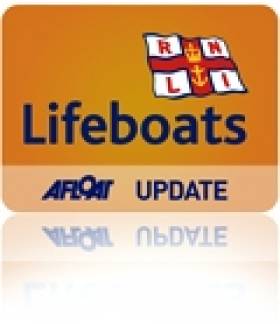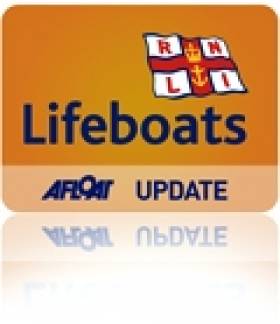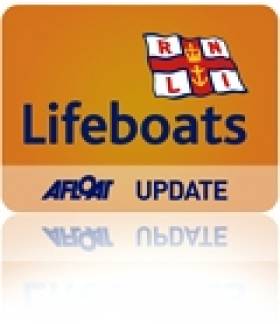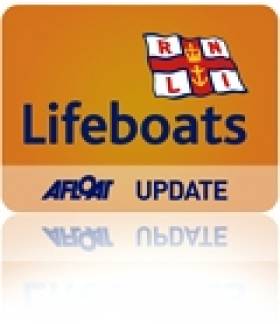Displaying items by tag: Lifeboats
Kilrush Lifeboat Launches To Boat Broken Free of Moorings
#RNLI - Kilrush RNLI launched on Sunday 15 September shortly after 1pm following a request from Valentia Coast Guard to go to the aid of a boat which had broken its moorings off Labasheeda in Co Clare.
The volunteer lifeboat crew assembled and launched immediately, heading for the indicated area. Conditions were blowing quite hard at the time, with north westerly winds blowing.
The crew battled their way to the scene reaching the location at 2pm, whereby they set up watch and located the 6.5m vessel on the rocks at an area known as Mount Trenchard, east of Glin, near Foynes in Co Limerick.
Weather conditions were very strong and gusting Force 8, and in the interest of safety the decision was made to leave the vessel which was securely placed where it had gone aground with a view to it being removed to Foynes Harbour the following morning.
Kilrush RNLI lifeboat operations manager John Lamb said he was happy with the outcome and in view of safety of his crew that the right call was made on this occasion.
Lifeboat Photographer Captures 'Courage On Our Coasts'
#Photography - A new book and exhibition showcasing striking photos of the lifesaving work of the RNLI were launched last week.
The Lifeboat: Courage On Our Coasts showcases over 400 iconic images captured through the lens of RNLI lifeboat crew member and award-winning professional photographer Nigel Millard, from dramatic shots of lifeboats battling fierce seas to candid portraits of the charity’s dedicated volunteer crew members, lifeguards and fundraisers.
Millard’s photos – the result of two years’ work – offer a unique eyewitness insight into the full scope of the RNLI’s lifesaving work.
To capture the images, Millard, who volunteers as a crew member at Torbay in Devon, visited RNLI lifeboat stations and lifeguard units around the UK and Ireland. At each station, Nigel carried a pager and was alerted to shouts, along with the local crew, to capture the action first-hand.
Hear Millard read an exerpt from his visit with Rosslare Harbour RNLI:
A selection of striking images from the book also features in a touring exhibition of the same name - the first time that photographs of the RNLI’s work have been made available to the public in this way. The exhibition will travel to locations including London, Manchester, Edinburgh, Cardiff, Dublin and Birmingham.
Copies of the book - written by Dr Huw Lewis-Jones, with the foreword by HRH The Duke of Cambridge - will be available to buy at the exhibition, along with other specially-designed merchandise featuring Nigel’s stunning images.
Nigel Millard says he hopes the images will give people a better understanding of the RNLI’s lifesaving work.
"My favourite photo is a casualty’s eye view," he says. "I’ve been a man overboard on exercises – once in the water, you see nothing, then just a tiny bit of orange, and it’s not the sun, it’s a lifeboat. It epitomises the work I do, and the work of the RNLI.
"I hope the exhibition will raise awareness of the charity. People who don’t know anything about rescue at sea will get to hear about it, they will know we’re here to help. Someone might be inspired to volunteer – not necessarily on the crew, but maybe as a fundraiser. Or some might wish to donate."
Dr Lewis-Jones, who accompanied Nigel on many of his photo shoots, says of the book and exhibition: "It’s a show of great photos that represent the best of the RNLI. It’s a way of reminding people that they are only ever 70 miles from the sea – we may all need the RNLI’s help.
"We’ve joined crews all around the country on shouts, but also for a cup of tea. The photos are a collection of what the RNLI family means, the true spirit of the RNLI – ordinary people doing extraordinary things."
The book’s will be available 30 September direct from the RNLI (www.rnlishop.org) as well as good bookshops and stockists including Amazon.
And in partnership with Epson, the RNLI is also running a photography competition, My Coast, while the exhibition is touring.
The charity is challenging photographers to capture what the varied and beautiful coasts of the British Isles mean to them. The winner will receive a large format print of an image of their choice from The Lifeboat: Courage on our Coasts exhibition, signed by the photographer Nigel Millard; a photo quality Epson colour printer (kindly donated by Epson); and a waterproof housing for an SLR camera and an iPhone waterproof housing (kindly donated by Cameras Underwater).
A shortlist of 10 entries will be selected by Nigel Millard. He will be looking for striking images that encapsulate the photographer’s experience of the British Isles coastlines and something of their relationship with the sea. The short-list will then go forward for a public vote on the RNLI’s Facebook page.
The closing date for entries is Monday 31 March 2014 and the winner will be notified by Monday 5 May 2014. Entries should be submitted by completing the online form at www.rnli.org/mycoast and emailing images as a JPEG file to [email protected].
For those who can’t make it to the exhibition, an online version will also be available at www.rnli.org/courageonourcoasts.
Skerries Lifeboat Joins Flare Search Off Gormanston
#RNLI - Skerries RNLI joined Clogherhead RNLI and Irish Coast Guard helicopter Rescue 116 in a search off Gormanston on Tuesday night (10 September) after reported sightings of distress flares in the area.
The volunteer crew launched their newly dedicated inshore lifeboat Louis Simson shortly after 8.30pm with Conor Walsh as helm and crew members Peter Kennedy, Stephen Crowley and Laura Boylan also on board.
Dublin Coast Guard requested the lifeboat to launch after receiving a number of reports of distress flares in the vicinity of the Gormanston area. Clogherhead RNLI and Rescue 116 were also tasked, with the former being assigned the role of on-scene coordinator for the search. Conditions on the night were calm with a force 1 to 2 North by North West wind.
Working together, the two lifeboats and the helicopter conducted an extensive search of the area. Just after 9.30pm, Dublin Coast Guard declared that they were satisfied the area had been searched thoroughly ,and with nothing found all units were stood down to return to base.
Speaking after the call-out, Skerries helm Walsh said: "Working together with Clogherhead lifeboat and the coastguard helicopter we were able to cover a large search area quickly.
"Distress flares are an important piece of safety equipment and are a very effective way of calling for help. Thankfully on this occasion no lives were in danger."
This is the second time in less than a month that Skerries RNLI responded to reports of distress flares, after launching to similar reports of flares north of Balbriggan on 14 August.
New Skerries Lifeboat Dedicated In Special Ceremony
#RNLI - Skerries RNLI officially named its new Atlantic 85 lifeboat Louis Simson at a special ceremony held today (Saturday 7 September), as reported yesterday on Afloat.ie.
David Delamer, a member of the Irish Council of the RNLI, accepted the lifeboat and her launching carriage on behalf of the RNLI before handing her over into the care of Skerries Lifeboat Station.
He paid tribute to the donor, Charlotte Simson, who had generously funded the lifeboat through a gift left in her will. The legacy was 75 years old.
Simson, who hailed from Salem in India, funded the lifeboat which has been on service in Skerries since February, in memory of her husband Louis, from London.
"Mrs Simson made provision in her will for a trust fund that would provide various relatives with a modest income for life," Delamer explained. "She arranged that once the trust fund had come to an end, the remaining money should fund an RNLI lifeboat to be named in memory of her beloved husband. Now three quarters of a century on, Mrs Simson’s wish will be granted."
Leo Cody, a founding member of the Skerries RNLI inshore lifeboat station and a former deputy launching authority, then officially named the lifeboat during the ceremony.
The new state-of-the-art Atlantic 85 lifeboat was introduced into the RNLI fleet in 2005. The lifeboat is 8.4 metres in length and weighs 1.8 tonnes. Improvements on its predecessor include a faster top speed of 35 knots, radar, provision for a fourth crew member and more space for survivors.
Since the new lifeboat went on service in Skerries, there have been 24 call-outs and 49 people have been brought to safety.
Niall McGrotty, Skerries RNLI lifeboat operations manager, said the naming ceremony and service of dedication was a special occasion in the history of the Skerries lifeboat station, adding that the volunteer crew was grateful to Simson for her generous legacy which had funded the lifeboat.
He added that the RNLI could not operate its lifeboats without the dedication of volunteer lifeboat crew.
"The crew in Skerries give 100% at all times. Their commitment and ongoing attendance for training both here and at the lifeboat college means that they are highly proficient in the operation of their lifeboat.
"Further testament of the dedication of the crew is their knowledge that they may risk their own lives in the service of others. There is nothing greater that a person could offer and they deserve nothing less than the best lifeboat, equipment and training that money can buy."
McGrotty went on to pay tribute to the vital support provided by the volunteers who support the crew.
"The lifeboat crew and I are only one part of this station. I must mention our operation team, supporters and fundraisers who volunteer their time and efforts and do so much for Skerries RNLI. These are people of all ages who give what time and money they can."
A crowd of well-wishers turned up to see the lifeboat officially named, with a bottle of champagne poured over the side of the boat before it launched at the end of the ceremony.
Among the guests were Des Frazer, president of the Skerries RNLI Lifeboat Management Group, who welcomed guests and opened proceedings; Leo Cody, who back in 1967 was appointed the honorary secretary of the Skerries fundraising branch and is a former deputy launching authority; and Brian Carty, a former crew member, deputy launching authority and chairman, who delivered the vote of thanks.
Father Richard Hyland, Reverend Anthony Kelly and Reverend David Nixon lead the Service of Dedication.
Bundoran Lifeboat Crew To Push The Boat Out This Saturday
#RNLI - Bundoran RNLI's annual boat push will take place this Saturday 7 September as the volunteer crew once again embark on the challenge of raising funds for the lifeboat station, which is entering its 40th year of existence.
The boat push will start outside the ambulance base on the Donegal Road in Ballyshannon at noon and members of the lifeboat crew will have buckets with them on the route for people to make a donation.
The route will take them through Ballyshannon, Finner and into Bundoran, finishing at the lifeboat station at Bundoran Pier, covering a distance of almost 10km in four to five hours.
The fundraising drive is just one of the events which helps to run Bundoran RNLI and keep the Atlantic 85 lifeboat William Henry Liddington maintained and ready to go at a moment’s notice.
The volunteer crew counts on the generous support of the public to ensure that the RNLI can continue to provide all year search and rescue coverage and we hope to get lots of support on Saturday.
"The boat push has now become an annual fixture in Bundoran RNLI's fundraising calendar and is something the volunteer crew at the station look forward to each year," said Bundoran RNLI volunteer lifeboat press officer Shane Smyth.
"Not only does it give us a chance to raise much needed funds to continue to run this voluntary service, it also gives us a chance to meet our supporters from the area who continually donate to us despite the tough financial times we find ourselves in."
Isle of Man Lifeboat Launches To Stranded Kayakers
#RNLI - Douglas RNLI lifeboat on the Isle of Man was launched last night (4 September) at the request of Douglas Coastguard following the report of two kayakers stranded on the seaward side of Douglas Breakwater.
The RNLI all-weather lifeboat Sir William Hillary was launched under the command of volunteer deputy second coxswain Graeme Cushnie, to assist the coastguards by illuminating the scene from seaward, allowing coastguard rescue officers to negotiate their way down the sea defence wall and bring the kayakers to safety.
Both kayakers having been reported as safe and well the lifeboat was able to recover both kayaks from the Irish Sea to the visitors’ pontoon at the Battery Pier.
Wicklow Lifeboat In Medivac From Survey Vessel
#RNLI - Wicklow RNLI carried out a medical evacuation of an unwell man from a survey vessel off the Wicklow coast in the early hours of yesterday morning (2 September).
The alarm was raised after the man was suspected to have been overcome with fumes on a survey vessel working near the Codling Buoy. The all-weather lifeboat launched at 2.45am and was alongside the survey vessel at 3.12am.
Conditions in the area at the time were described as moderate sea with wind southwest Force 3.
The casualty was transferred onto the lifeboat by stretcher and as the lifeboat returned to Wicklow, the crew administered first aid and monitored the casualty.
Due to the low tide in the harbour at the time, the casualty was transferred to the inshore lifeboat and landed ashore at 3.50am. He was met on arrival by a waiting ambulance crew who took him to hospital.
Speaking after the call-out, Wicklow RNLI lifeboat operations manager Des Davitt said: "This was a typically professional response by the volunteer crew of Wicklow lifeboat, who launched within seven minutes of being paged."
The all-weather lifeboat crew launched under coxswain Nick Keogh with mechanic Brendan Copeland, Ciaran Doyle, Carol Flahive, Paul Sillery, Graham Fitzgerald and Peter McCann on board. The inshore crew were helm Barry Spencer, Dave O'Leary and Brian Sinnott.
Wicklow Lifeboat Launches To Flare Sighting
#RNLI - Wicklow RNLI carried out a search of Wicklow Bay on Saturday night (31 August) after the Irish Coast Guard received a 999 call to report a distress flare sighting.
Both Wicklow's all-weather and inshore lifeboats were requested and launched just before 9pm and a search of the shoreline from the Six Mile Point and bay was conducted.
Conditions in the area at the time presented a calm sea state and there was good visibility.
After an extensive search of the area nothing was found. The lifeboats were stood down and returned to the lifeboat station shortly before 10pm.
Speaking after the call-out, Wicklow RNLI coxswain Nick Keogh said: "We made contact with some anglers on Kiloughter beach and spoke to the crew of a passing yacht in the search area and they hadn't seen anything."
The crew on the inshore lifeboat were helm Graham Fitzgerald, Dean Mulvihill and Peter McCann. The all-weather lifeboat crew were coxswain Nick Keogh, mechanic Tommy Murphy, Ciaran Doyle, Dave O'Leary, Carol Flahive and Brain Sinnott.
Busy Weekend For Portaferry Lifeboat With Two Call-Outs
#RNLI - Portaferry RNLI had a busy start to the weekend with two call-outs last Friday (30 August).
The first call was received just before 3pm from a 5m Shetland open-top fishing vessel with two men and one child on board, who had lost power and run onto rocks near the entrance to Ardglass Harbour in Co Down.
The volunteer crew were on the water by 3.05pm and arrived on the scene 15 minutes later. Weather at the time was cloudy with good visibility and Force 4 northwest winds.
When the lifeboat crew arrived at the scene, the two men and the child had managed to climb onto the rocks to safety where they were met by a member of the coastguard.
The fishing vessel had lost power and by the time the crew could attempt to start the auxiliary engine the boat was washed onto the rocks. The lifeboat crew could do nothing to salvage the quickly sinking boat and remained at the scene until the two men and the child had been taken to safety.
The second call of the day was received at 9pm from a man and a teenager aboard a 27ft yacht that had lost engine power and was adrift close to the Fairway Buoy at the entrance to Strangford Lough in Co Down.
The volunteer crew launched at 9.07pm and were with the stricken yacht at 9.55pm after conducting a short search. The weather was fair with Force 4 to 5 northwest winds.
The lifeboat crew attached a line to the yacht and then proceeded to tow it nearly five miles to the safety of Portaferry Marina where they arrived at 11.20pm. The yacht was then securely moored in the marina and the two people on board safely put ashore.
Portaferry RNLI lifeboat operations manager Brian Bailie said: "It was certainly a busy start to the weekend for our volunteer crews and thankfully everyone was returned home safely.
"The skipper of the yacht which lost power at the mouth of Strangford Lough exercised good judgement calling for assistance when he did rather than attempting to sail back in what can be extremely tricky waters."
Achill Island Lifeboat Attends Injured Woman Off Mayo Cliffs
#RNLI - Achill Island RNLI was tasked to assist a young woman in distress off the cliffs of Old Head in Louisburgh, Co Mayo yesterday afternoon (28 August).
The volunteer lifeboat crew sped to the scene around 4pm yesterday after the woman, who had been diving from a cliff into the sea, was injured on entering the water and required urgent assistance.
As the lifeboat was en route, some of the woman’s friends managed to pull her from the water onto nearby rocks, below the cliff, to await help.
The lifeboat arrived shortly after and sent two crewmen ashore to administer first aid. Westport Coast Guard Unit and Rescue 115, the helicopter from Shannon, were also tasked to the scene.
The woman was taken on board the lifeboat and transferred to the helicopter, which took her to Castlebar General Hospital where her injuries were treated.
Lifeboat operations manager Tom Honeyman said: “This had been a very busy but fulfilling year for the volunteer lifeboat crew with this, the 20th shout so far in 2013.
"It is also another good example of the different wings of the emergency services working in tandem to affect a successful outcome.”


























